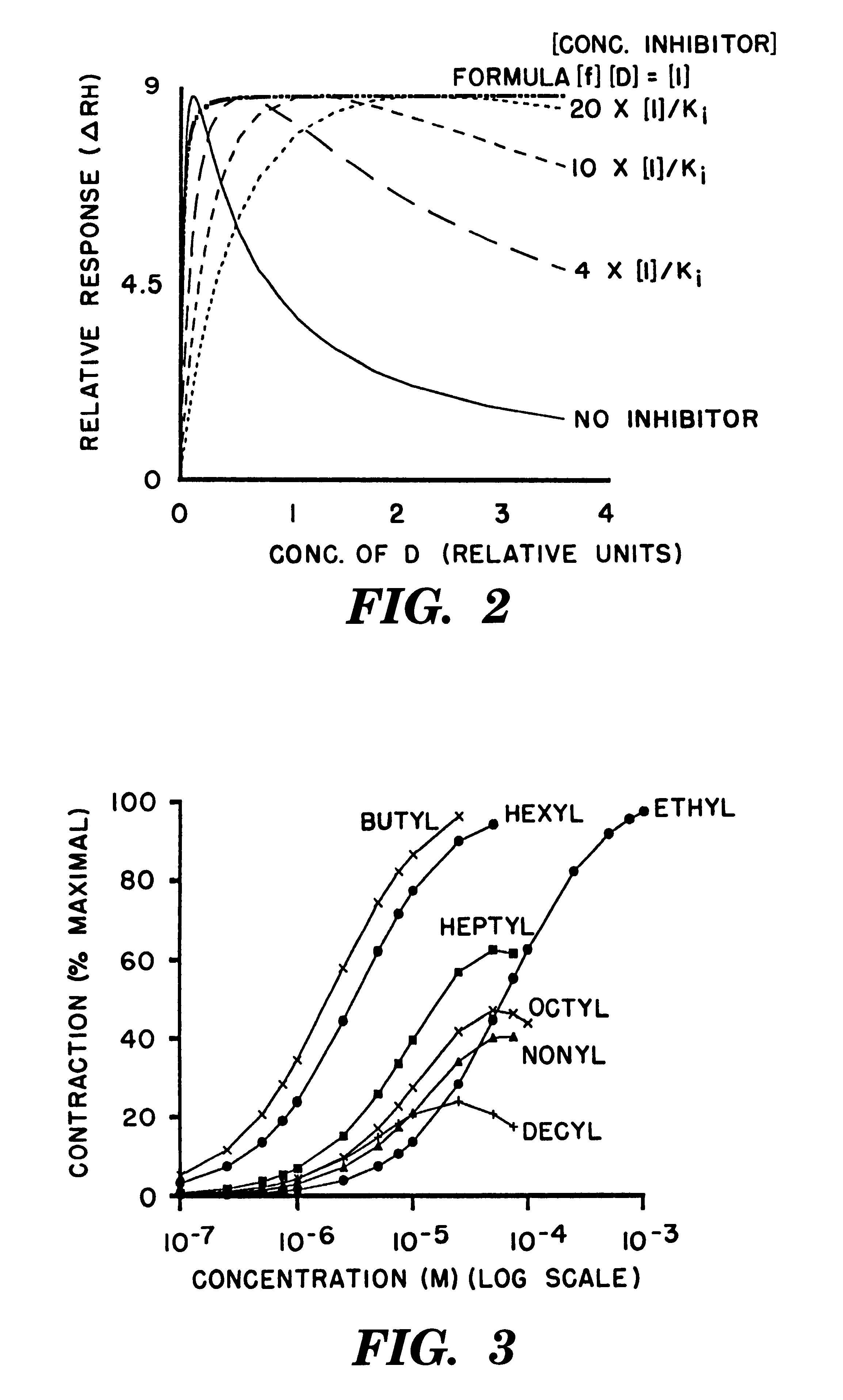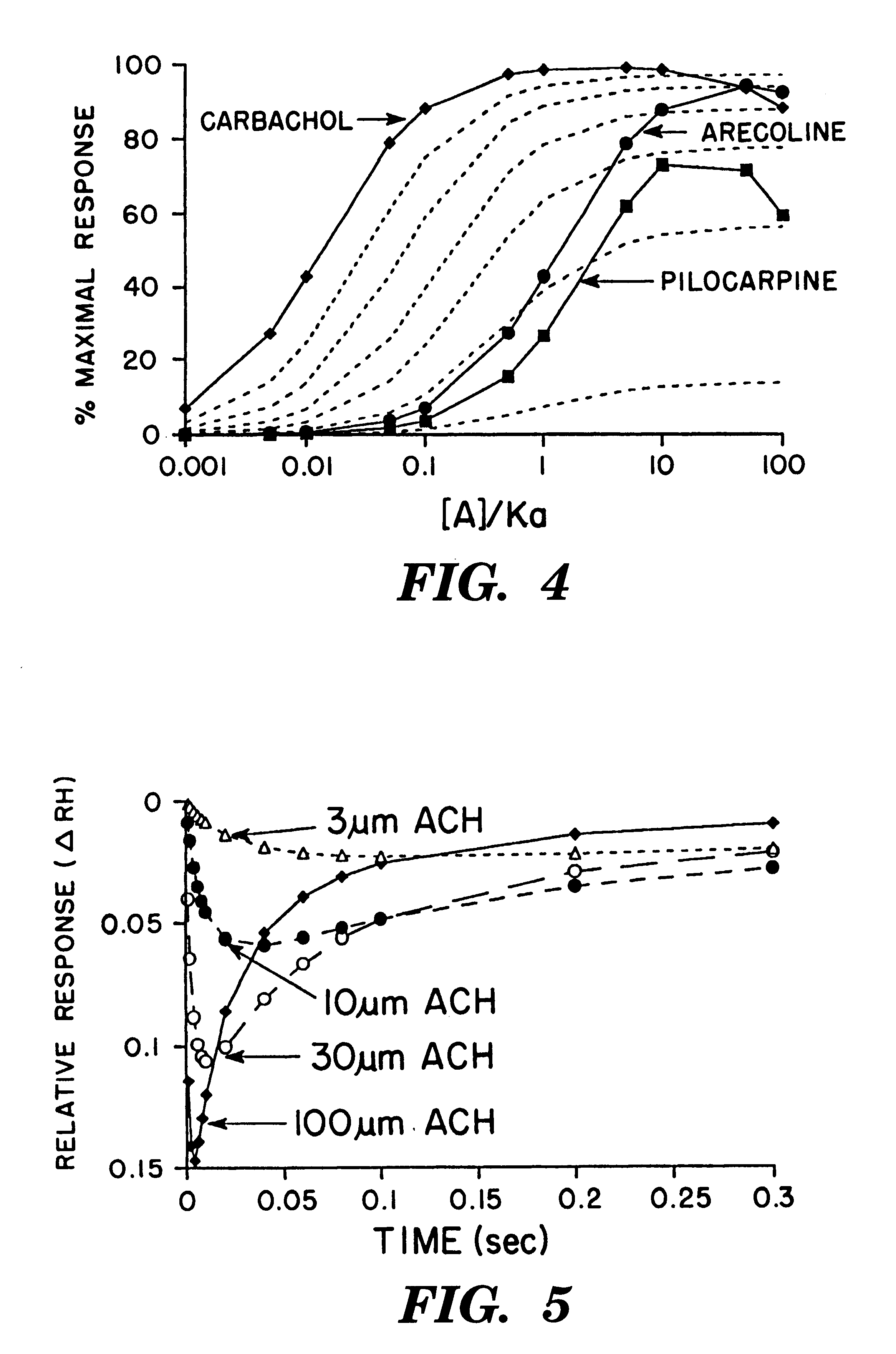Drug compositions to prevent desensitization of cellular receptors
a technology of desensitization and drug composition, applied in the direction of biocide, instruments, animal husbandry, etc., can solve the problems of inability to accurately predict the response of receptors, the receptor theory fails to describe the observed response, and the phenomenon of rapid desensitization is difficult to model
- Summary
- Abstract
- Description
- Claims
- Application Information
AI Technical Summary
Problems solved by technology
Method used
Image
Examples
example 1
Stephenson's data (Stephenson, R. P., British. J. Pharmacol. 11, 379-393 (1956)) are presented in FIG. 3. The points on these curves were generated by equation [6]. The value for both of the R.sub.H and R.sub.L terms was 50 and the values of the pairs of K.sub.DH and K.sub.DL terms were as follows: Butyl (3.times.10.sup.-6, 8.times.10.sup.-2); Hexyl (5.times.10.sup.-6, 2.times.10.sup.-3); Ethyl (1.times.10.sup.-4, 1.times.10.sup.1); Heptyl (2.times.10.sup.-5, 3.times.10.sup.-4); Octyl (3.times.10.sup.-5, 2.times.10.sup.-4); Nonyl (4.times.10.sup.-5, 2.times.10.sup.-4); and Decyl (3.times.10.sup.-5, 2.times.10.sup.-4). The concentration of drug [D] is represented on the abscissa in a molar log scale.
The reader will note that equation [6] can represent the experimental data from Stephenson with meaningful physicochemical parameters (i.e. the two dissociation constants of the drugs for the two receptor states).
example 2
Referring once again to FIG. 4, the plots of .DELTA.RH (equation [6]--solid lines) for the data of Keen (Keen, 1991) are presented for arecoline, pilocarpine and carbachol as well as the plots of the operational model (broken lines). .DELTA.RH was calculated with 300 as the value for the R.sub.H and R.sub.L terms to scale the curves appropriately. The K.sub.DH and K.sub.DL terms were varied in order to model the experimental curves. The K.sub.DH and K.sub.DL values for arecoline were 2 and 2000 respectively; similarly, the values for pilocarpine were 4 and 220; and the values for carbachol were 0.02 and 1000.
The Equation to Calculate the Curves for the Operational Model: ##EQU8##
where A represents agonist parameters and R receptor and ([R.sub.o ] / K.sub.AR)=16, 7.3, 3.5, 1.3 and 0.116 with .alpha.=100% (plotted as the broken lines in the graph). K.sub.A is the overall dissociation constant for the binding of the agonist to the receptor as defined in the operational model.
Experimental...
example 3
As depicted in FIG. 5, the response curves of Dilger and Brett are modeled by .DELTA.RH with a diffusion equation, [D].sub.t, to represent the change in concentration with time and a recruitment function, R.sub.F, to describe the diffusional recruitment of receptors. The diffusion coefficient used for acetylcholine (ACH) is 6.times.10.sup.-10 m.sup.2 s.sup.-1, which is a generally accepted value. The values for the R.sub.H and R.sub.L terms are one for this graph. the apparent affinity constant for the diffusional recruitment of receptors, K.sub.F, is 20 .mu.M as determined by the half maximal change in the peak heights of the experimental curves. Where "t" is the time in seconds and "900.times.10.sup.-12 " is the square of the distance (30.times.10.sup.-6 m). The K.sub.DH and K.sub.DL values of acetylcholine are 0.01 and 0.1 respectively.
The series of equations to calculate .DELTA.RH are: ##EQU11##
where the last four equations are operationally equivalent to equation [6] for .DELTA...
PUM
| Property | Measurement | Unit |
|---|---|---|
| diffusion distance | aaaaa | aaaaa |
| affinity | aaaaa | aaaaa |
| dissociation constants | aaaaa | aaaaa |
Abstract
Description
Claims
Application Information
 Login to View More
Login to View More - R&D
- Intellectual Property
- Life Sciences
- Materials
- Tech Scout
- Unparalleled Data Quality
- Higher Quality Content
- 60% Fewer Hallucinations
Browse by: Latest US Patents, China's latest patents, Technical Efficacy Thesaurus, Application Domain, Technology Topic, Popular Technical Reports.
© 2025 PatSnap. All rights reserved.Legal|Privacy policy|Modern Slavery Act Transparency Statement|Sitemap|About US| Contact US: help@patsnap.com



